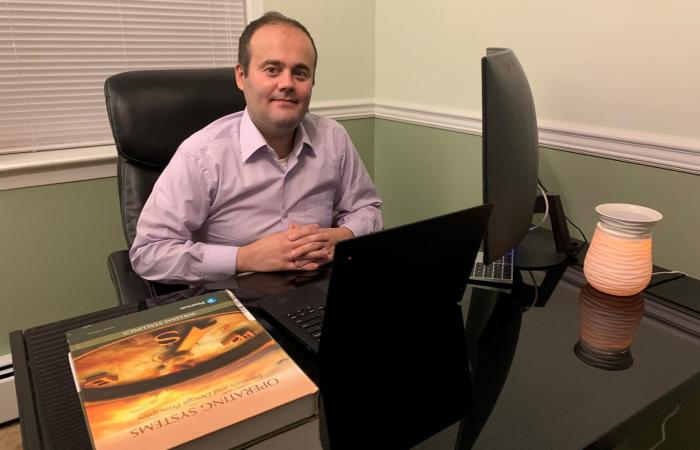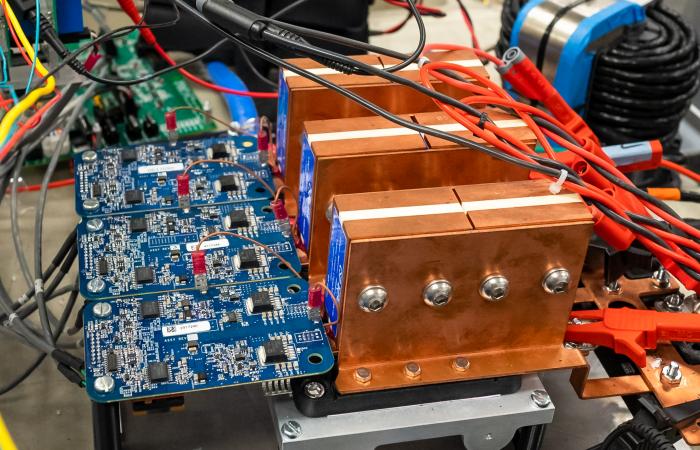-

Erdem Asa is leveraging his power electronics expertise to adapt ORNL's wireless charging technology to unmanned aerial vehicles. Credit: Erdem Asa/ORNL, U.S. Dept. of Energy
-

he Oak Ridge Converter invented by Erdem Asa at ORNL supports low-cost, compact infrastructure for wireless charging in the transportation sector. Credit: Carlos Jones/ORNL, U.S. Dept. of Energy
-

Erdem Asa is leveraging his power electronics expertise to adapt ORNL's wireless charging technology to unmanned aerial vehicles. Credit: Erdem Asa/ORNL, U.S. Dept. of Energy
-

he Oak Ridge Converter invented by Erdem Asa at ORNL supports low-cost, compact infrastructure for wireless charging in the transportation sector. Credit: Carlos Jones/ORNL, U.S. Dept. of Energy
Having co-developed the power electronics behind Oak Ridge National Laboratory's compact, high-level wireless power technology for automobiles, Erdem Asa is looking to the skies to apply the same breakthrough to aviation.
An engineer who spent the early part of his career at GE Aviation, Asa's current work at ORNL is centered on adapting the lab's wireless charging to unmanned aerial vehicles, or UAVs.
The COVID-19 pandemic put a spotlight on the need for efficient, last-mile and contactless delivery of goods to consumers, with companies such as Amazon studying how drones might fit the bill. But commercial drone systems can't carry much package weight and still fly far on a single charge using current battery technology.
A system of wireless charging stations installed along key delivery routes could remedy the issue, said Asa, an electrical engineer in the Buildings and Transportation Science Division.
"Right now a suitable drone can only fly about 10 to 20 minutes," Asa said. In his vision, wireless charging pads would be installed atop light poles, for instance, along key delivery routes so that drones can alight as needed and quickly recharge for the next leg of their journey.
ORNL's wireless charging technology transfers power across an air gap between an electromagnetic coil on a charging pad and another on the vehicle. Since being first demonstrated in 2016 at the 20-kilowatt level, ORNL has achieved dramatic improvements to the system to enable its installation on a wider range of vehicles and at much higher power levels. The hands-free, safe and efficient technology advances one of the nation's key decarbonization strategies: electrifying transportation, a sector that emits more greenhouse gases than any other.
Along those lines, Asa pointed out the potential for emissions reductions if more last-mile deliveries - say, the meal you ordered from a restaurant or the packages you ordered online - relied on electric drones.
"With this system, we can protect the environment, we can safeguard public health and basically provide a social benefit," he said. That goal of a social benefit to technology is a key driver for Asa in his work.
"We've had some difficult days in the pandemic. But technology can help us with some of our challenges, like a cleaner environment and making life a little easier. I'm excited to work with partners in industry to get this technology into the marketplace," Asa noted.
Asa recently worked to engage industry partner HEVO in a project to refine the lab's wireless charging system for commercial use under a U.S. Department of Energy Technology Commercialization Fund award, with accompanying licensing of the technology. He is currently looking for industry partners to help further develop the UAV charging technology.
Scaling power electronics for real-world use
He is the inventor of the Oak Ridge Converter, one of the technologies that makes the wireless charging system attractive for real-world use. The converter eliminates one of the power conversion stages needed for wireless power transfer, resulting in more compact and less costly infrastructure, as much as a 50% reduction in size, volume and weight. That work in turn has led to the kind of innovation Asa is engaged in now to apply the system to drones.
Asa credits the multidisciplinary, supportive environment of the lab for the success of the wireless charging program and its wide applicability. "Our team at ORNL really comes together and supports one another as we take big ideas from the benchtop to the real world, working with industry to get technology out there that can make a difference," he said.
Growing up in Turkey, Asa's mother was the one who encouraged her son to apply his early interest in gadgets to a career as an engineer. He worked as a technician in a TV repair shop while in high school, where he learned to take apart and reassemble small systems.
"I recently lost her, but she was the one who encouraged me all the time, from primary school all the way through college and graduate school," he said. Asa earned his doctorate in electrical and computer engineering under Professor Dariusz Czarkowski at New York University's Tandon School of Engineering in Brooklyn, where part of his studies included wireless power transfer.
He worked at GE Aviation for three years as a design and control power electronics engineer before becoming interested in the power electronics and wireless power transfer work going on at ORNL. He followed the LinkedIn posts of ORNL Corporate Fellow and power electronics expert Burak Ozpineci regarding the lab's wireless charging developments, and joined ORNL in 2019.
"One of the best things at ORNL is you can work on such a variety of projects. You're encouraged and supported to apply your experience in the pursuit of new ideas," Asa said. "All the projects I've worked on here are very exciting. Right now, I'm excited at getting our wireless technology into UAVs. The sky's the limit."






